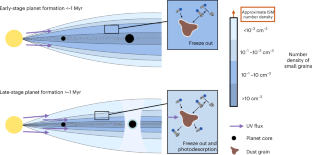2023-01-11 カリフォルニア大学バークレー校(UCB)
世界的に見ると、ハーバーボッシュ法によるアンモニア製造は、化石燃料全体の約1%を使用し、二酸化炭素排出量も全体の1%を占めており、気候変動の主な原因となっている。
このたび、カリフォルニア大学バークレー校の化学者たちが、アンモニア生産をより環境にやさしいものにするための大きな一歩を踏み出した。
より少ないエネルギーでアンモニアを製造するための大きな障害は、ハーバーボッシュ法で必要とされる大きな温度と圧力の変動を伴わずに、アンモニアを反応物(主に窒素と水素)から分離することであった。ハーバーボッシュ法では、約300〜500℃の温度で反応が起こるが、アンモニアは気体を約-20℃まで冷却して除去し、気体のアンモニアは凝縮して液体となる。また、このプロセスでは、反応物を大気圧の約150〜300倍まで加圧する必要がある。これには化石燃料のエネルギーが必要である。
アンモニア分離の代替法があれば、より過酷な条件下で行う代替プロセスへの道が開けるかもしれない。この問題に対処するため、カリフォルニア大学バークレー校の化学者たちは、中程度の圧力と175℃前後の温度でアンモニアを結合・放出する多孔質材料、有機金属骨格(MOF)を設計・合成した。MOFはいかなる反応物質とも結合しないため、アンモニアの回収と放出は、より小さな温度変動で達成でき、エネルギーの節約になる。
スナイダーは、銅原子をシクロヘキサンジカルボキシレートという有機分子で連結し、剛直で多孔質のMOF構造を作り上げた、比較的新しい種類のMOFを試したのである。驚いたことに、アンモニアはこのMOFを破壊せず、銅とアンモニアを含むポリマーに変化させ、アンモニアを極めて高い密度で貯蔵することができた。さらに、このポリマー鎖は、比較的低い温度で結合したアンモニアを容易に放出し、その過程で、当初の硬く多孔性のMOF構造に回復した。
スナイダーは、MOFが、広い範囲の圧力下でアンモニアを吸収・放出するように調整できることを発見し、持続可能な反応物質から最も効率的にアンモニアを生成するために最適な反応条件が判明した場合に、より適応性を高めることが出来そうです。
「つまり、特定のプロセスで特定の反応条件にロックインすることになった場合、MOFの性能パラメーター、つまりこの吸着剤に使用する温度と圧力を、特定のアプリケーションに密接に一致するように変更することができるのです」。
Snyderは、アンモニア捕捉は、より環境に優しいアンモニアを作るための修正プロセスの一部に過ぎず、それはまだ進行中であることを強調しました。
<関連情報>
- https://news.berkeley.edu/2023/01/11/a-big-step-toward-green-ammonia-and-a-greener-fertilizer/
- https://www.nature.com/articles/s41586-022-05409-2
有機金属骨格におけるNH3協同捕獲のための配位子挿入機構 A ligand insertion mechanism for cooperative NH3 capture in metal–organic frameworks
Benjamin E. R. Snyder,Ari B. Turkiewicz,Hiroyasu Furukawa,Maria V. Paley,Ever O. Velasquez,Matthew N. Dods & Jeffrey R. Long
Nature Published:11 January 2023
DOI:https://doi.org/10.1038/s41586-022-05409-2

Abstract
Ammonia is a critical chemical in agriculture and industry that is produced on a massive scale via the Haber–Bosch process1. The environmental impact of this process, which uses methane as a fuel and feedstock for hydrogen, has motivated the need for more sustainable ammonia production2,3,4,5. However, many strategies that use renewable hydrogen are not compatible with existing methods for ammonia separation6,7,8,9. Given their high surface areas and structural and chemical versatility, metal–organic frameworks (MOFs) hold promise for ammonia separations, but most MOFs bind ammonia irreversibly or degrade on exposure to this corrosive gas10,11. Here we report a tunable three-dimensional framework that reversibly binds ammonia by cooperative insertion into its metal–carboxylate bonds to form a dense, one-dimensional coordination polymer. This unusual adsorption mechanism provides considerable intrinsic thermal management12, and, at high pressures and temperatures, cooperative ammonia uptake gives rise to large working capacities. The threshold pressure for ammonia adsorption can further be tuned by almost five orders of magnitude through simple synthetic modifications, pointing to a broader strategy for the development of energy-efficient ammonia adsorbents.



